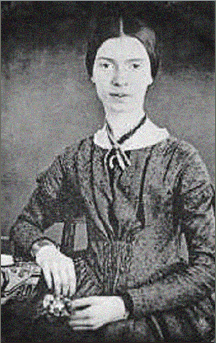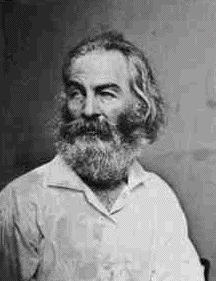 |
LITR 4232 American
Renaissance 2012 final exam—Answers to Question B5 "compare and contrast poems by Whitman and Dickinson" final exam assignment |
 |
April Bucy
The Lyric and the Catalog: A Parable of Poetry
Walt Whitman and Emily Dickinson are both characterized as poets of the American
Renaissance that mastered the sing-song style known specifically as the lyric
poem. A lyric poem as defined by the course syllabus is “a
brief subjective poem strongly marked by imagination, melody, and emotion, and
creating for the reader a single, unified impression.” They are generally the
expressions of “feelings and thoughts of a single narrator” and may be
identified by a melody containing “a variety of rhythm patterns” that are
“expressed either in rhymed or unrhymed verses” (“Dickinson”).
The subject matter of a lyric
poem differs by author as demonstrated by Walt Whitman in the poem “A Noiseless
Patient Spider,” where a spider is used as a metaphor for human beings and their
quest for progress. The spider is described as “noiseless and patient,” both
qualities that are often attributed to humans and both of which combined with
the repetition of the word “filament” seem emblematic of the spider’s dedication
and ability to persevere and work hard. The poem was written in a time when the
concept of manifest destiny was prevalent and is seen in the third line of the
poem which states, “Marked how to explore the vacant vast surrounding.” Here the
“vacant vast surrounding” could be the unsettled American west or it could be
referencing the vastness of the human mind as implied in the previous line by
the term “promontory” as well as the spider and human metaphor earlier stated.
Concepts of manifest destiny however are seen later in the poem, “Ceaselessly
musing, venturing, throwing, seeking the spheres to connect them/ Till the
bridge you will need be formed, till the ductile anchor hold,” and imply that
only through perseverance and hard-work can progress prevail. These shifting of
ideals are characteristic of Whitman’s choice of subject matter and often center
on the “development of urban lifestyle” (“Whitman”).
In addition to development of urban lifestyle, Walt
Whitman chose to write poetry with subjects that dealt with identification and
inclusiveness, sexual release and exchange, mystical transcendence and
absorption as well as the shifting relations between self and the other
(“Whitman”). In the poem “There was a Child Went Forth,” for example, the lines
“And
the first object he look'd upon, that object he became, / And that object became
part of him for the day or a certain part of the day” directly classify the self
as “other” by identifying it as an object. The child in the poem stands out
isolated and developed both of which are characteristic of Whitman subject
matter and is found specifically in the line, “His own parents, he that had
father'd him and she that had conceiv'd/ him in her womb and birth'd him.”
Another element of Whitman poetry found in both of these poems is the copious
overflowing of detail known as cataloging. An example of this particular style
in “A Noiseless Patient Spider” would be “musing,
venturing, throwing” while in “There was a Child Went Forth” is observed in the
lines “The
father, strong, self-sufficient, manly, mean, anger'd, unjust,/ The blow, the
quick loud word, the tight bargain, the crafty lure.”
Moreover, both poems are examples of
Whitman’s use of free verse in conjunction with the sing song aspect of lyric
poetry. Free verse “ideally
adapts to, conforms to, or reflects the thought or impulse
of the poem, instead of tailoring the thought to fit the form” and is never
“completely free of poetic conventions” such as “figures of speech,
alliteration, assonance, and occasional or interior rhymes” (“Whitman”). An
illustration of this is found in the lines, “Till
the bridge you will need be form'd, till the ductile anchor hold, / Till the
gossamer thread you fling catch somewhere, O my soul” where the repetition of
“till the” creates an anaphora another construction of Whitman and free verse.
In
contrast, Emily Dickinson in her poem, “There’s Been a Death in the Opposite
House” undertakes a subject indicative of her in particular, the confrontation
with death as an inevitable aspect of human life. Other subject matters often
attributed to Dickinson are the notions of mystical visions, sexual unions,
nature as a symbol of spirit and finally, the intrusion of the infinite into
everyday life (“Dickinson”). The matter of fact manner Dickinson uses to
describe death in the poem as well as its setting, a house in “just a country
town” helps to describe the inevitability and universality of death as an
experience. Dickinson’s description of the window that “opens
like a pod, / Abrupt, mechanically” is an interesting association, although
significant because here the use of pod, as a plant and an important
aspect of nature, also serves as a metaphor for the human spirit. Human life is
much like the life cycle of a pod, for example when life is “ripe” and is near
its end, it would burst out, just like human beings (or perhaps a butterfly
trapped inside a cocoon) with the intention to finish its respective purposes
and quests.
This
brings us to the discussion of Dickinson’s personal poetic style, which is often
characterized by sudden shifts of identity or metaphor, as indicated in the
forth stanza of “There’s been a Death in the Opposite House,” with the use of
minister followed by
mourners then
little boys where the shift between
subject appears erratic. The use of personification is also distinctive of
Dickinson’s style, “I felt a funeral in my brain, /And mourners, to and fro,”
gives humanistic traits to an object previously indisposed to those type of
actions. Another feature associated with Dickinson’s poetry is the paradoxical
combination of the abstract with the concrete, as demonstrated in the poem, “I
Felt a Funeral in My Brain,” by the lines, “And I and Silence some strange Race/
Wrecked, solitary, here,” where the word
silence is abstract in direct contrast with the term
wrecked which is concrete.
As a final point, Whitman and Dickinson both use the lyric poem as an expression of their particular subject matter; however, each author provides a unique aspect of which readers remain to be entertained and enlightened. Both Whitman and Dickinson indicate interests in the association of nature with human life as well as an occupation with mystical and sexual transcendence. Nonetheless, there are significant differences in their independent styles where Whitman prefers free verse and the catalog of details, Dickinson sticks true to opportunistic rhymes and the quatrain. Despite these differences, it can be argued that both Whitman and Dickinson are masters of the poetic craft and have been influential not only to poetry written during the American Renaissance but also to poetry written today.
|
|
|

